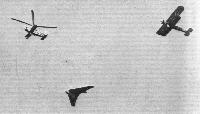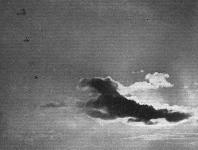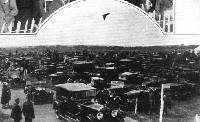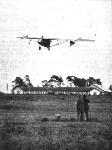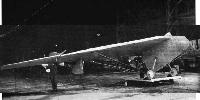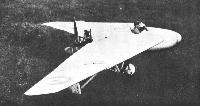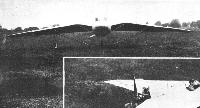
Flight, April 1926
THE TAILLESS AEROPLANE
Dunne Type developed according to Modern Knowledge
THE paper read by Capt. G. T. R. Hill, M.C., M.Sc, A.F.R.Ae.S., before the Royal Aeronautical Society on April 22, proved a most interesting one. The author of the paper, as has been known for some considerable time, has been working away quietly on the evolution of a new type of aeroplane, or rather the development of an old type, since actually the type is not new, tailless aeroplanes having been built long before the war, and several of them flown with more or less success.
It is a somewhat curious fact that with the very considerable amount of experience with tailless aeroplanes the type should have been allowed to drop entirely at the outbreak of war, and that it should be taken up again seriously as a type which certainly appears at the moment to have certain not inconsiderable advantages.
In his paper, Capt. Hill outlined the history of the "Pterodactyl," as he had named his tailless machine, from the time he first began quietly to examine the problem of safe flight to the completion of the first official test flight with the power-driven machine at the R.A.E. Farnborough. Space does not permit of following the lecturer through the whole of his paper, nor is this necessary, since those sufficiently interested in that side of the paper will be able to read it in full in a forthcoming issue of the Royal Aeronautical Society's Journal.
Capt. Hill began by contemplating the large number of fatal accidents occurring every year in the Royal Air Force, and he came to the conclusion that a very large percentage of these was due to loss of control. The task which he set himself was therefore that of designing an aeroplane which would never, through an error on the part of the pilot, get out of control. The lecturer showed a number of slides illustrating the power, or lack of power, of normal controls, and in the design of his machine he started off with the idea that the wing to be used should have a stationary centre of pressure. Two ways were open to attain this object: the reflexed trailing edge of a rectangular wing, and the swept back wing with diminishing angle of incidence towards the tips. After going into the subject Capt. Hill decided that the loss of maximum lift and L/D was likely to be less with the swept back wing than with the reflexed straight wing. He therefore chose the former type as the basis of his design, and gave the leading edge a sweep back of 31 deg., while that of the trailing edge was 14 deg. This gave a wing tapering in plan form, and the washout, or decrease of incidence towards the tip, was 3 deg. at the strut attachments and 6 deg. at the tip. The wing section used was that known as airscrew 4 at the strut attachment, the ordinates of all the other sections being proportional to it. As a result of model tests in the wind-tunnel it was decided to give the sections a slightly reflexed trailing edge, so that actually the final section is slightly different from airscrew 4, in that the trailing edge is raised 0-015 times the chord.
Attached to the wing, which is of fairly normal construction, is a short fuselage or nacelle, in the front of which is the pilot's cockpit, while in the power-driven machine the Bristol "Cherub" is mounted at the back of the nacelle, driving a pusher airscrew. The undercarriage legs run through the sides of this nacelle and the shock absorbers are placed inside. As the machine had been designed with rather high factors of safety, and as the space was not being otherwise utilised, it was decided as an afterthought to turn the machine into a two-seater, by adding a second seat between the pilot and the engine. Under the tail end of the nacelle is fitted a small wheel supported by an arrangement not unlike that of the front forks of a bicycle, so as to allow the wheel to swivel. For steering on the ground the wheel is geared to the rudder bar.
Capt. Hill first tested the machine as a glider and found that even at very low speeds the controls were effective, and having ascertained this, he proceeded to install the engine so as to test the machine as a power-driven light 'plane. Up to this point Capt. Hill had been doing all the work of designing, and most of the construction himself, but the results were so encouraging that when he approached the Aeronautical Research Committee it was recommended that wind tunnel tests be carried out, and also that encouragement in the form of financial assistance and helpers, not to mention shed space, be given. Consequently, Capt. Hill was able to transfer the scene of his activities to the Royal Aircraft Establishment at Farnborough, where the installation of the engine and certain minor modifications to the machine were carried out.
The Hill tailless machine does not merely consist in what might be termed a modern version of the pre-war Dunne machines, but incorporates a number of features which were not to be found in the original Dunne. Chief among these should perhaps be placed what Capt. Hill calls the "contrailers." These are pivotted wing tips, so arranged that no matter at what angle of incidence the main wing is flying the controllers are always lying along wind, that is to say they may be described as "floating." The advantage of this type of control over ordinary ailerons is that when the main wing approaches the stall the controllers are still neutral and thus have their full range of movement up or down available for control. As expected this was found to give adequate lateral control at angles which would be beyond the stall in an ordinary aeroplane. In point of fact Capt. Hill stated that the "Pterodactyl" did not show a decided stalling point, as does an ordinary normal aeroplane, and when following a flight path inclined approximately 45 deg., the machine itself is almost on a level keel. Actual flight tests had demonstrated that the "controllers" in the first machine were rather unnecessarily large (no less than one quarter of the total wing area) and in future machines it seems likely that the area of these controllers can safely be considerably reduced, while still retaining ample controllability. While on the subject of the "controllers" it should be pointed out that these serve, when operated separately, as ailerons, while when worked together up and down, being placed aft of the centre of gravity of the machine, their function is that of elevators.
The rudders of the Hill "Pterodactyl" are vertical surfaces, one on each side, placed below the wing and some considerable distance out. Normally these rudders are free to trail, and for turning to the right, for instance, the right rudder is turned so as to form an angle with the flight path of the machine. The resistance or drag thus set up on the right-hand side swings the machine to the right, since the left-hand rudder is still left trailing, and thus offers no extra resistance. It might have been thought that by now Capt. Hill had done all that could be expected or was necessary. He had secured adequate lateral and longitudinal control for all attitudes of the machine, and he had provided rudders which were equally effective for the work which they had to do. The inventor of the "Pterodactyl" was not, however, content with this, but decided that by providing a separate control for the rudders he could operate them in such a way that they would form air brakes. This was attained by setting the two rudders over at a large angle to the flight path, the rudders, of course, swinging out symmetrically - that is to say, the trailing edge of the right-hand rudder moving outwards to the right and that of the left-hand rudder to the left. As the centres of pressure of the rudders are approximately on a level with the centre of resistance of the whole aeroplane, the trim should not be appreciably altered by the use of the rudders as air brakes, and in actual flying tests this was found to be the case. Moreover, it was found that by moving the two rudders simultaneously to their full extent the resistance of the machine was approximately doubled. In other words, the gliding angle was halved. With the Hill "Pterodactyl" it is thus possible for a pilot, if he realises that he is likely to overshoot the mark, to put on his air brake, thus making the gliding angle steeper, without any necessity for side-slip or any similar stunt landings. A most valuable feature of the "Pterodactyl" has been found to be that it is possible to change from the stalled to the unstalled state without diving. The enormous advantage of this is that if the machine is accidentally brought into the stalled condition (in so far as a machine without any definite stalling-point can be said to be stalled in the ordinary sense of the word) when close to the ground, the pilot can bring it back to the unstalled condition without any appreciable loss of height. It would almost appear that if the "Pterodactyl" possessed no other advantage than that, this alone would be sufficient to make it worth while developing it further.
The designer of the "Pterodactyl" is, however, of the opinion that the tailless machine can be built with a smaller percentage structure weight than the normal machine. Another advantage is that it is possible to revert to the pusher type of aeroplane without loss of performance, while it is thought that an improvement can be made in the general arrangement of the flying-boat by employing the tailless design.
An appendix to Capt. Hill's paper contained the main data relating to the "Pterodactyl," and, as the figures are of considerable interest, they are given below. The machine has an overall span of 45 ft. The area of the main plane is 223 sq. ft., and the area of the controllers 55 sq. ft. The area of the rudders is 13 sq. ft. The weight empty varies slightly, according to whether large or small wheels are fitted to the undercarriage. With large wheels the empty weight is 458 lbs., and with small wheels 444 lbs. The weight of petrol and oil is 30 lbs., and of pilot 170 lbs. The total loaded weight of the machine as a single-seater is 658 lbs., and as a two-seater 828 lbs. The wing loading of the two-seater is 3-7 lbs. per square foot, and the power loading 25 lbs. per horse-power. The speed range Capt. Hill stated to be from about 70 m.p.h. to about 30 m.p.h.
- Flight, April 1926
THE TAILLESS AEROPLANE
Фотографии
-
Aeroplane Monthly 1986-01 / 1986 UK Aircraft Collections and Museums Guide
Регистрационный номер: J8067 [5] Westland Pterodactyl IA J8067.
-
Aeroplane Monthly 1973-07 / R.King, H.Penrose - The Ptailless Ones
Регистрационный номер: J8067 [5] The first powered Pterodactyl, bearing its military serial J8067, performs as "new type” No. 1 at the Hendon Pageant, July 7, 1926.
-
Air International 1984-10 / In print
Harald Penrose was also closely involved in testing the Westland-Hill Pterodactyls.
-
Aeroplane Monthly 1994-04 / 1994 UK Aircraft Collections and Museums Guide
Регистрационный номер: J8067 [5] AS HARD TO BELIEVE AS ITS NAMESAKE: The Hill "Pterodactyl" trying its hardest, but without success, to stall.
The 1926 Pterodactyl J8067 is exhibited in the Science Museum, South Kensington. -
Flight 1926-12 / Flight
THE BOOMERANG: Plan view, from below, of Capt. Hill's tailless'aeroplane "Pterodactyl." This view was secured with the camera pointing almost vertically upward.
-
Flight 1926-07 / Flight
The Hill "Pterodactyl" (Bristol "Cherub") The tail-less machine is no novelty, Colonel Dunne having produced aeroplanes of this type in the very earliest days of flying, but in the "Pterodactyl" Capt. G. T. R. Hill has incorporated, in addition to the "tailless" feature, the modern knowledge of aerodynamics, with the result that his machine is freed from the bugbear of aviation, "stalling," as well as possessing other important features. The tips of the backswept wings are pivoted and act as elevators and ailerons, while separate rudders project below each wing. The tailless machine appears to promise the possibility of a return to the "pusher" (i.e., engine-behind) type without loss of efficiency.
-
Aeroplane Monthly 1974-09 / ??? - Hendon Pageantry 1920-37
Регистрационный номер: J8067 [5] The Westland Pterodactyl 1A J8067 at the 1926 pageant.
-
Air Pictorial 1973-06 / P.Lewis - The Ptale of the Pterodactyls (1)
The Hill Pterodactyl Mk.I in fully stalled flight.
-
Flight 1930-07 / Flight
The "Freak Formation": The Cierva Autogiro in the lead, with the Handley Page Gugnunc on the left and the Hill Pterodactyl on the right.
Другие самолёты на фотографии: Cierva/Avro C.19 - Великобритания - 1929Handley Page Gugnunc / H.P.39 - Великобритания - 1929
-
Flight 1930-10 / Flight
The Handley Page "Gugnunc," the "Autogiro," and the Westland-Hill Pterodactyl formating at Croydon.
Другие самолёты на фотографии: Cierva/Avro C.19 - Великобритания - 1929Handley Page Gugnunc / H.P.39 - Великобритания - 1929
-
Flight 1926-07 / Flight
THE R.A.F. DISPLAY AT HENDON: The Seventh Display beat all previous records as regards the number of spectators (and their motor cars) present, as may be seen here.
-
Flight 1926-04 / Flight
COMING IN TO LAND: The Hill "Pterodactyl" is seen in this view in a fairly normal attitude. Note that the "controllers" are trailing, i.e., are lying along wind, and form an angle with the main wing.
-
Flight 1930-07 / Flight
The Pterodactyl (original model).
-
Flight 1926-04 / Flight
THE TAILLESS AEROPLANE: Three-quarter front view of the Hill "Pterodactyl" with Bristol "Cherub" engine at R.A.E. Farnborough. The wing tips are pivoted to form "controllers" (ailerons and elevators). The rudders are mounted under the wing, and are provided with skids.
-
Air Pictorial 1973-06 / P.Lewis - The Ptale of the Pterodactyls (1)
Регистрационный номер: J8067 [5] Thr same aircraft at the 1926 R.A.F. Display at Hendon.
-
Flight 1926-04 / Flight
George Button by the nose of the Hill Pterodactyl Mk.I at R.A.E. Farnborough before the first flight on 2nd November 1925
Note the fixed vertical fins above the wing.
-
Flight 1940-09 / Flight
The Hill Pterodactyl Mark Ia
-
Air Pictorial 1973-06 / P.Lewis - The Ptale of the Pterodactyls (1)
Two views of the Cherub-powered Westland-Hill Pterodactyl Mk. IA under construction at Yeovil. The nacelle seated two side-by-side
-
Flight 1928-06 / Flight
Регистрационный номер: J9251 [2] Capt., later Prof. Geoffrey T. R. Hill's Westland Pterodactyl lb, first flown in mid-June 1928, was, perhaps, the most visually pleasing of this series of tailless aircraft produced by Westland under his design leadership. A former chief test pilot for Handley Page, the Captain had devoted much of his efforts during the 1921 to 1924 period attempting to devise a safe, stall-proof aircraft. Aided by a 3-year research scholarship and subsequent support from the Royal Aircraft Establishment, Hill brought forth his first tailless glider at the end of 1924 and, built with the aid of RAE, a much improved powered version in the autumn of 1925. Hill joined Westland during the spring of 1926, where he embarked on the design of the machine shown here, which carried the Air Ministry serial J9251. This machine in its Mk. lb form was powered by a 70hp Armstrong Siddeley Genet mounted as a pusher. From the outset of flight trials with this machine it showed a marked propensity for flying along in a series of up and down oscillations rather than remaining level, a trait that may well have been aided by Hill's use of more than ample aero-isoclinic controls. In this system the wingtips swivel around the main spar to provide pitch control if used in unison, or roll control if used differentially. Top speed was 70mph.
-
Air Enthusiast 1996-07 / A.Pelletier - Towards the ideal aircraft? (1)
The Westland-Hill Pterodactyl IB featured all-movable wingtips, as well as the so-called ‘electroscopic rudders’ which, when open differentially acted as rudders, and opened together served as airbrakes. This machine was eventually modified as Pterodactyl IC when a tandem-wheel gear was installed.
-
Flight 1940-09 / Flight
The Pterodactyl Mark Ib.
-
Aeroplane Monthly 1973-07 / R.King, H.Penrose - The Ptailless Ones
The IB taxies past at the 1928 Hendon Display with its electroscopic rudders open.
-
Air Pictorial 1973-06 / P.Lewis - The Ptale of the Pterodactyls (1)
The Westland-Hill Pterodactyl Mk. IB with Genet engine and single mainwheel - seen at Andover
-
Flight 1928-06 / Flight
WESTLAND-HILL "PTERODACTYL 1A": Experimental tailless two-seater, with Armstrong-Siddeley "Genet" Engine.
-
Air Pictorial 1973-06 / P.Lewis - The Ptale of the Pterodactyls (1)
The Westland-Hill Pterodactyl Mk. IB with Genet engine and single mainwheel - seen at Yeovil
-
Aeroplane Monthly 1973-07 / R.King, H.Penrose - The Ptailless Ones
Регистрационный номер: J9251 [2] A rare air-to-air view of Pterodactyl IB J9251.
-
Flight 1928-07 / Flight
EXTREMES: Pterodactyl (Genet) in flight
-
Aeroplane Monthly 1973-07 / R.King, H.Penrose - The Ptailless Ones
The IC variant with tandem-wheel main unit and skids outboard.
-
Flight 1930-07 / Flight
THE LATEST "PTERODACTYL": This is the machine which it had been intended to show at the R.A.F. Display. It differs from that shown in the official Display programme in that the wheels are in tandem. The engine is an Armstrong Siddeley "Genet."
-
Air Pictorial 1973-06 / P.Lewis - The Ptale of the Pterodactyls (1)
Alternative 1923 Hill tailless wing forms. Design "C" was evolved Into "D5" which had small rudders, as shown in detail drawing
-
Air Pictorial 1973-06 / P.Lewis - The Ptale of the Pterodactyls (1)
Hill 1923 tailless two-seat fighter project; Hill 1924 Pterodactyl glider
-
Aeroplane Monthly 1973-07 / R.King, H.Penrose - The Ptailless Ones
Hill Pterodactyl
-
Air Enthusiast 1996-07 / A.Pelletier - Towards the ideal aircraft? (1)
Westland-Hill Pterodactyl I.
-
Air Pictorial 1973-06 / P.Lewis - The Ptale of the Pterodactyls (1)
Hill 1925 Pterodactyl Mk.I
-
Air Pictorial 1973-06 / P.Lewis - The Ptale of the Pterodactyls (1)
Westland-Hill Pterodactyl Mk.IA/IB/IC
-
Aeroplane Monthly 1973-07 / R.King, H.Penrose - The Ptailless Ones
Westland-Hill Pterodactyl IB
- Фотографии








